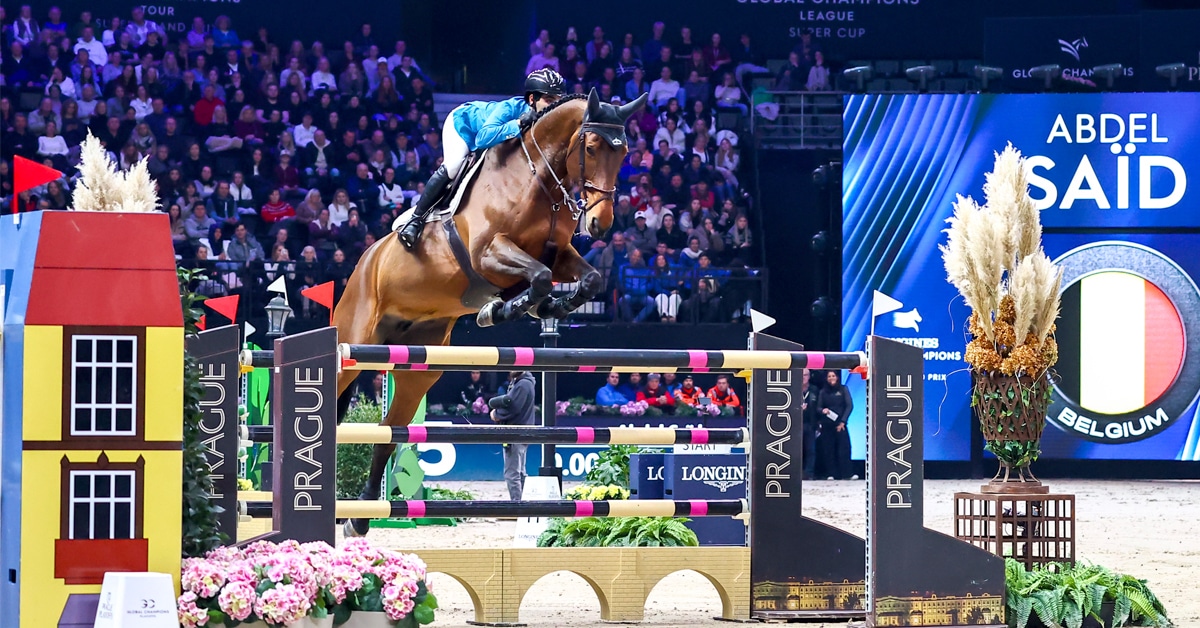Over 1,000 photos of jumping rider Andy Kocher were submitted to the FEI’s investigators, with an apparent trigger device visible in 73 of them, it has emerged.
Kocher, who early this spring was suspended for 10 years for using electric spurs on multiple horses, went to considerable lengths to conceal the practice, the FEI Tribunal has concluded. Yet his use of the device was an open secret, with former staff and owners testifying they were fully aware.
The FEI Tribunal has just released its 54-page reasoned decision after announcing the operative part previously. The document shows the role of un-named whistleblowers in bringing the case to light, and also the FEI’s astonishment that Kocher has shown no remorse.
One whistleblower went to the French magazine Grand Prix last year, as well as to the FEI”s Equine Community Integrity Unit (ECIU) in May 2020. A number of photos were sent to the ECIU after the first few news reports. As a result of pending investigations, Kocher was provisionally suspended in June last year. The US rider has also had his results disqualified from various national shows and eight international shows (including Spruce Meadows) where the device was allegedly used over several seasons.
The three-day Tribunal hearing was told that the device was a modified electrical power bank, to which a trigger button and cables with exposed endings were attached. It was strapped to Kocher’s body, with a trigger in his hand and the trigger cable running down the arm under the sleeves. Two other cables ran down the rider’s legs, with the exposed cable ends connected to his spurs.
Kocher “went to great lengths to conceal such devices from FEI officials over these years, by hiding the wires under his clothes via holes in his boots, making it barely visible to any official.” The trigger button was the same color as his gloves, so “extremely discreet from any FEI official.”
Videos submitted showed how such a device worked. The FEI was also supplied with Kocher’s old boots, which one witness, a former owner, had taken after they were replaced. The boots contained holes allegedly for the cables to run through. Arrangements were made for Kocher and his legal representatives to inspect the boots, but were not followed through by the rider.
The FEI said the device would force the horse to be more sensitive to riding aids such as legs to move forward and accelerate, exempting instances where the horse would not comply with this “abusive aid, resulting in increased bolting, rearing, bucking” when compared to aids used normally.
Kocher’s aim, it was alleged, was to change unwanted behaviour. The device had several purposes. One so-called benefit was to provide an immediate acceleration in between obstacles or within an A-B or A-B-C combination, or to prevent a nervous horse from stopping, whether at a particular obstacle, throughout the course or to force a tired horse to continue at a certain pace.
Kocher argued it was a clicker trainer, and he attached it to a cord to avoid losing it. But two former employees testified they never saw or heard of him using a clicker.
One former employee recalled Kocher’s horses reacting in “a volatile and temperamental manner around him,” and seemed very sharp off the leg. He would often go to get changed in a trailer yet emerge in the same clothes. She and another former employee both recalled seeing him with the device at a show and instructing his employees to use them, too.
One employee who had used the device as demanded by Kocher freely admitted this to the FEI, and was confident he would not be prosecuted himself. Under cross-examination he denied he had helped Kocher design the device. He encountered Kocher at a gas station, who pressured him to withdraw his statement.
The former owner testified she had asked Kocher not to use the electric spurs on her horses, feeling they were cruel, but was told they were humane. The use was a “daily routine” and Kocher was open about it.
Kocher seemed to need to use the bathroom “numerous times” before and after a class. Sometimes when he fell off he would refuse medical help or anything that required him to take off his jacket.
The former owner was asked about the reason for submitting the device to the ECIU years after the event. She explained she had time to reflect on all the circumstances that arose through her work dealings and during the Covid-19 pandemic when things were quiet. She came forward to “fulfil a moral obligation.”
A freelance groom who met Kocher in June 2019 said that horses that were usually calm showed very high levels of stress when Kocher rode them, rearing, shivering and bolting. This could not be explained by excessive use of normal spurs. Then in October 2019 she saw Kocher holding what looked like the same device when she was wiping a horse’s neck prior to entering the ring. Kocher often wore sweaters in very warm weather, which made it seem like he was hiding something.
Another rider who claimed to be a friend of Kocher’s from childhood said he saw Kocher using the device as early as 2013 or 2014 at a show in Iowa. They were stabled in the same barn. When the witness entered the tack stall he heard a “large series of pops and snapping noises.” Kocher and his groom were working on something on a table – black wires attached to spurs with a rectangular battery pack. Kocher told him they were “electric spurs and that they were too hot.” They had been trying to fix them for a few days.
It was not until the story broke last year that this witness was “horrified” to realise Kocher was still using them. He recognised he should have reported it sooner. Kocher flatly denied knowing this witness.
In his defence, Kocher said said the relationship with his owner broke down, and there are lawsuits pending in the US. He had fired one of the employee witnesses because of work issues. It was the witness who had used the device, and colluded against Kocher with other witnesses. No official had seen him use the device at more than 1,200 shows.
Kocher did not produce any evidence to show he had used clicker devices instead, saying they were worth only about $5 and so were disposed of, as the springs did not last long. He trained by himself so people would not know he used clickers.
He was unable to answer Tribunal queries about the length of the cord used down the sleeve in conjunction with the “clicker.” The Tribunal noted that in general, Kocher was able to produce little evidence either to support his use of the clicker, or to refute any of the witness testimony. The witnesses had “comfortably” satisfied the case against Kocher.
Throughout, Kocher vehemently denied using electric spurs.
In 2002 Kocher was given six months jail time and probation of four years for theft of two ponies and a goat. He and an accomplice smothered the goat to death. The FEI felt this prior behaviour showed the rider’s conduct towards animals.
The Tribunal concluded: “The breaches are exacerbated by the length of time over which the use continued, the number of horses involved and the encouragement of their use by other riders over whom the Respondent had influence. It is in fact an example not only of horse abuse but also of gross cheating over a lengthy period; to the great detriment of the reputation of the sport, the Respondent’s owners and the other riders in his competitions, not to mention the criminality in some jurisdictions.
“The Respondent’s conduct during the hearing, including flat denials and consequently a total lack of remorse, only makes matters worse. When the FEI asked for minimum five years suspension it did not know that the Respondent would persist in his denials which the Tribunal has found to be untrue, nor did it expect the total lack of remorse inherent in his case.
“The Tribunal are satisfied that 10 years is a proportionate penalty under these guidelines on foot on all the evidence in this case, and that more serious sanctions than the minimum requested by the FEI are required.”
More News









